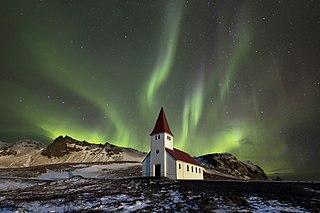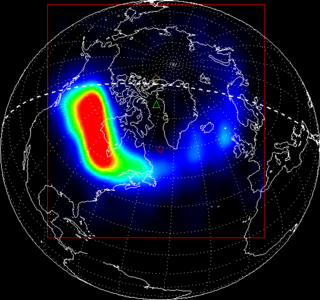
The solar wind is a stream of charged particles released from the upper atmosphere of the Sun, called the corona. This plasma mostly consists of electrons, protons and alpha particles with kinetic energy between 0.5 and 10 keV. The composition of the solar wind plasma also includes a mixture of materials found in the solar plasma: trace amounts of heavy ions and atomic nuclei of elements such as Carbon, Nitrogen, Oxygen, Neon, Magesium, Silicon, Sulfur, and Iron. There are also rarer traces of some other nuclei and isotopes such as Phosphorus, Titanium, Chromium, and 58Ni, 60Ni, and 62Ni. Superimposed with the solar-wind plasma is the interplanetary magnetic field. The solar wind varies in density, temperature and speed over time and over solar latitude and longitude. Its particles can escape the Sun's gravity because of their high energy resulting from the high temperature of the corona, which in turn is a result of the coronal magnetic field. The boundary separating the corona from the solar wind is called the Alfvén surface.

An aurora , also commonly known as the northern lights or southern lights, is a natural light display in Earth's sky, predominantly seen in high-latitude regions. Auroras display dynamic patterns of brilliant lights that appear as curtains, rays, spirals, or dynamic flickers covering the entire sky.

A solar flare is a relatively intense, localized emission of electromagnetic radiation in the Sun's atmosphere. Flares occur in active regions and are often, but not always, accompanied by coronal mass ejections, solar particle events, and other eruptive solar phenomena. The occurrence of solar flares varies with the 11-year solar cycle.

Space weather is a branch of space physics and aeronomy, or heliophysics, concerned with the varying conditions within the Solar System and its heliosphere. This includes the effects of the solar wind, especially on the Earth's magnetosphere, ionosphere, thermosphere, and exosphere. Though physically distinct, space weather is analogous to the terrestrial weather of Earth's atmosphere. The term "space weather" was first used in the 1950s and popularized in the 1990s. Later, it prompted research into "space climate", the large-scale and long-term patterns of space weather.

A geomagnetic storm, also known as a magnetic storm, is a temporary disturbance of the Earth's magnetosphere caused by a solar wind shock wave.

A whistler is a very low frequency (VLF) electromagnetic (radio) wave generated by lightning. Frequencies of terrestrial whistlers are 1 kHz to 30 kHz, with maximum frequencies usually at 3 kHz to 5 kHz. Although they are electromagnetic waves, they occur at audio frequencies, and can be converted to audio using a suitable receiver. They are produced by lightning strikes where the impulse travels along the Earth's magnetic field lines from one hemisphere to the other. They undergo dispersion of several kHz due to the slower velocity of the lower frequencies through the plasma environments of the ionosphere and magnetosphere. Thus they are perceived as a descending tone which can last for a few seconds. The study of whistlers categorizes them into Pure Note, Diffuse, 2-Hop, and Echo Train types.

The solar cycle, also known as the solar magnetic activity cycle, sunspot cycle, or Schwabe cycle, is a nearly periodic 11-year change in the Sun's activity measured in terms of variations in the number of observed sunspots on the Sun's surface. Over the period of a solar cycle, levels of solar radiation and ejection of solar material, the number and size of sunspots, solar flares, and coronal loops all exhibit a synchronized fluctuation from a period of minimum activity to a period of a maximum activity back to a period of minimum activity.

A coronal mass ejection (CME) is a significant ejection of magnetic field and accompanying plasma mass from the Sun's corona into the heliosphere. CMEs are often associated with solar flares and other forms of solar activity, but a broadly accepted theoretical understanding of these relationships has not been established.
A solar storm is a disturbance on the Sun, which can emanate outward across the heliosphere, affecting the entire Solar System, including Earth and its magnetosphere, and is the cause of space weather in the short-term with long-term patterns comprising space climate.

Cluster II is a space mission of the European Space Agency, with NASA participation, to study the Earth's magnetosphere over the course of nearly two solar cycles. The mission is composed of four identical spacecraft flying in a tetrahedral formation. As a replacement for the original Cluster spacecraft which were lost in a launch failure in 1996, the four Cluster II spacecraft were successfully launched in pairs in July and August 2000 onboard two Soyuz-Fregat rockets from Baikonur, Kazakhstan. In February 2011, Cluster II celebrated 10 years of successful scientific operations in space. In February 2021, Cluster II celebrated 20 years of successful scientific operations in space. As of March 2023, its mission has been extended until September 2024. The China National Space Administration/ESA Double Star mission operated alongside Cluster II from 2004 to 2007.
A sudden ionospheric disturbance (SID) is any one of several ionospheric perturbations, resulting from abnormally high ionization/plasma density in the D region of the ionosphere and caused by a solar flare and/or solar particle event (SPE). The SID results in a sudden increase in radio-wave absorption that is most severe in the upper medium frequency (MF) and lower high frequency (HF) ranges, and as a result often interrupts or interferes with telecommunications systems.

Ionospheric storms are storms which contain varying densities of energised electrons in the ionosphere as produced from the Sun. Ionospheric storms are caused by geomagnetic storms. They are categorised into positive and negative storms, where positive storms have a high density of electrons and negative storms contain a lower density. The total electron content (TEC) is used to measure these densities, and is a key variable used in data to record and compare the intensities of ionospheric storms.

The Carrington Event was the most intense geomagnetic storm in recorded history, peaking from 1–2 September 1859 during solar cycle 10. It created strong auroral displays that were reported globally and caused sparking and even fires in multiple telegraph stations. The geomagnetic storm was most likely the result of a coronal mass ejection (CME) from the Sun colliding with Earth's magnetosphere.

The March 1989 geomagnetic storm occurred as part of severe to extreme solar storms during early to mid March 1989, the most notable being a geomagnetic storm that struck Earth on March 13. This geomagnetic storm caused a nine-hour outage of Hydro-Québec's electricity transmission system. The onset time was exceptionally rapid. Other historically significant solar storms occurred later in 1989, during a very active period of solar cycle 22.
Superflares are very strong explosions observed on stars with energies up to ten thousand times that of typical solar flares. The stars in this class satisfy conditions which should make them solar analogues, and would be expected to be stable over very long time scales. The original nine candidates were detected by a variety of methods. No systematic study was possible until the launch of the Kepler space telescope, which monitored a very large number of solar-type stars with very high accuracy for an extended period. This showed that a small proportion of stars had violent outbursts. In many cases there were multiple events on the same star. Younger stars were more likely to flare than old ones, but strong events were seen on stars as old as the Sun.

The three-day May 1921 geomagnetic storm, also known as the New York Railroad Storm, was caused by the impact of an extraordinarily powerful coronal mass ejection on Earth's magnetosphere. It occurred on 13–15 May as part of solar cycle 15, and was the most intense geomagnetic storm of the 20th century.

In solar physics, a solar particle event (SPE), also known as a solar energetic particle event or solar radiation storm, is a solar phenomenon which occurs when particles emitted by the Sun, mostly protons, become accelerated either in the Sun's atmosphere during a solar flare or in interplanetary space by a coronal mass ejection shock. Other nuclei such as helium and HZE ions may also be accelerated during the event. These particles can penetrate the Earth's magnetic field and cause partial ionization of the ionosphere. Energetic protons are a significant radiation hazard to spacecraft and astronauts.

Solar phenomena are natural phenomena which occur within the atmosphere of the Sun. They take many forms, including solar wind, radio wave flux, solar flares, coronal mass ejections, coronal heating and sunspots.

The solar storms of August 1972 were a historically powerful series of solar storms with intense to extreme solar flare, solar particle event, and geomagnetic storm components in early August 1972, during solar cycle 20. The storm caused widespread electric‐ and communication‐grid disturbances through large portions of North America as well as satellite disruptions. On 4 August 1972 the storm caused the accidental detonation of numerous U.S. naval mines near Haiphong, North Vietnam. The coronal mass ejection (CME)'s transit time from the Sun to the Earth is the fastest ever recorded.
Solar radio emission refers to radio waves that are naturally produced by the Sun, primarily from the lower and upper layers of the atmosphere called the chromosphere and corona, respectively. The Sun produces radio emissions through four known mechanisms, each of which operates primarily by converting the energy of moving electrons into electromagnetic radiation. The four emission mechanisms are thermal bremsstrahlung (braking) emission, gyromagnetic emission, plasma emission, and electron-cyclotron maser emission. The first two are incoherent mechanisms, which means that they are the summation of radiation generated independently by many individual particles. These mechanisms are primarily responsible for the persistent "background" emissions that slowly vary as structures in the atmosphere evolve. The latter two processes are coherent mechanisms, which refers to special cases where radiation is efficiently produced at a particular set of frequencies. Coherent mechanisms can produce much larger brightness temperatures (intensities) and are primarily responsible for the intense spikes of radiation called solar radio bursts, which are byproducts of the same processes that lead to other forms of solar activity like solar flares and coronal mass ejections.














